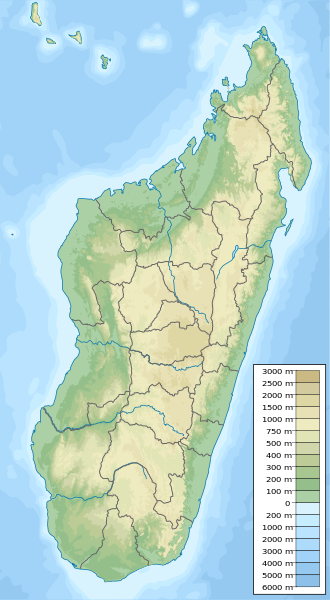Biodiversity
The lowland humid evergreen forest ecosystem making up much of Tsitongambarika is one of the most threatened vegetation types in Madagascar, and the forests of Tsitongambarika are found to be floristically and faunistically distinct from lowland humid evergreen forests elsewhere in Madagascar. [5] Tsitongambarika forests are mainly distributed below 800 m altitude and, almost uniquely for humid forests in south-eastern Madagascar, include significant areas below 400 m. [5]
Botanical collecting in the 2000s found at least seventy new species. [6] [3] The reserve supports areas of intact low- and mid-elevation, dense, humid evergreen forest, and sclerophyllous montane forest. At low elevations the canopy is at 15 m to 25 m and dominated by Dracaena, Ilex, Oncostemum , Sorindeia , Syzygium and Tambourissa . At mid-elevations the canopy is 12 m to 20 m high with trees of Macaranga and Oncostemon, as well as species of Guttiferae, Monimiaceae, Moraceae, and Myrtaceae. [7]
The forest on Mount Ivohibe (677 m) (more than one on the island with the same name) is an isolated peak with a relatively undisturbed forest. An expedition, organised by the Royal Botanic Gardens, Kew in 2010 recorded twenty species of palms making it one of the richest sites for palms in the southern part of the island. Sixteen species are either rare or threatened species according to the IUCN Red List. Expedition members considered the forest on Ivohibe to be a 'site of major palm significance'. [3]
The area supports a large number of endemic, rare, and threatened species, and many of the amphibians and reptiles found at the site are likely to be new to science. The mountains of Anosy Region are one of the two areas in Madagascar with the highest number of globally threatened amphibian species, and the Anosy Region is also one of the richest in Madagascar for reptile species, with a number of species not known from elsewhere in the country. [5]
The brown mesite (Mesitornis unicolor) is a ground-dwelling bird of undisturbed primary, evergreen, humid forest and its population is thought to be declining rapidly. It is listed as vulnerable due its habitat along the eastern seaboard of Madagascar being fragmented. [8] [9] Other key species include Madagascar blue-pigeon (Alectroenas madagascariensis), Madagascar wood-rail (Mentocrex kioloides), nelicourvi weaver (Ploceus nelicourvi), nuthatch vanga (Hypositta corallirostris), red-fronted coua (Coua reynaudii), scaly ground-roller (Geobiastes squamiger), spectacled tetraka (Bernieria zosterop) and white-throated oxylabes (Oxylabes madagascariensis). [2]
Ecosystem services
In addition to being an important site for forest and biodiversity conservation, Tsitongambarika serves as the principal watershed for the region, providing water for irrigation and for Fort-Dauphin town, protecting the catchments of two of the Anosy region's major rivers: the Manampanihy and Efaho. [3] [5] The forest provides numerous other ecosystem goods and services that ensure the economic and cultural well-being of the surrounding population, including firewood, charcoal, construction materials, bushmeat and medicinal plants. Since the local economy is largely subsistence-based and there is a high incidence of poverty, local communities have a high level of dependence on forest products to meet their daily needs. [5]


